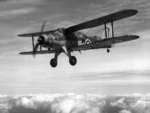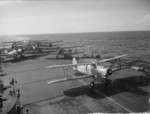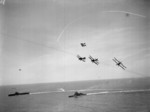Albacore
| Country | United Kingdom |
| Manufacturer | Fairey Aviation |
| Primary Role | Torpedo Bomber |
| Maiden Flight | 12 December 1938 |
Contributor: C. Peter Chen
ww2dbaseDesigned by Marcelle Lobelle of Fairey Aviation in response to Specification S.41/36 as a replacement for the Swordfish torpedo bombers, the Albacore torpedo bombers remained of a biplane design, but they were equipped with sleeker bodies and more powerful engines. Despite being outperformed by contemporaries, they were still considered effective carrier-borne torpedo bombers as they required a much shorter takeoff and landing distance than more powerful monoplanes. Production began in 1939.
ww2dbaseThe 826 Naval Air Squadron Fleet Air Arm received their first Albacore aircraft in Mar 1940; these first examples were shore-based, and were used to patrol and attack German shipping in the English Channel. In Nov 1940, they were deployed to carriers, starting with HMS Formidable, and Albacore pilots found that although they were more powerful than the Swordfish aircraft that the Albacore aircraft had replaced, they were less agile due to the heavier weight. Albacore torpedo bombers saw action in North Africa, with the Mediterranean convoys, and during the invasions of Sicily and Italy. One squadron of Albacore aircraft served out of Malta during the period of persistent Axis attacks; they were used mainly to attack Italian targets at Sicily. The Royal Canadian Air Force also operated Albacore aircraft, which were used during the Normandy invasion in 1944 as reconnaissance aircraft. In the Pacific War, the No. 36 Squadron Royal Air Force operated Albacore torpedo bombers in Java, which were captured by the Japanese in Mar 1943.
ww2dbaseProduction ceased in 1943 as Albacore aircraft were being replaced by Barracuda and Avenger torpedo bombers, and they were retired from front line service in late 1943; interestingly, they were retired before their supposed-predecessors, the Swordfish torpedo bombers. A total of 800 Albacore torpedo bombers were built.
ww2dbaseSource: Wikipedia.
Last Major Revision: Jun 2008
Albacore Timeline
| 12 Dec 1938 | Albacore aircraft took its first flight. |
| 26 Nov 1940 | No. 826 and No. 829 Squadrons of the British Fleet Air Arm embarked on carrier HMS Formidable for convoy escort duties to Cape Town, South Africa. |
SPECIFICATIONS
Albacore
| Machinery | One Bristol Taurus II 14-cylinder radial engine rated at 1,065hp |
| Armament | 1x7.7mm forward machine gun, 1x or 2x7.7mm rear Vickers K machine guns, 1x760kg torpedo or 900kg of bombs |
| Crew | 3 |
| Span | 12.14 m |
| Length | 15.24 m |
| Height | 4.62 m |
| Wing Area | 57.90 m² |
| Weight, Empty | 3,295 kg |
| Weight, Loaded | 4,755 kg |
| Weight, Maximum | 5,727 kg |
| Speed, Maximum | 259 km/h |
| Speed, Cruising | 225 km/h |
| Service Ceiling | 6,310 m |
| Range, Normal | 1,143 km |
Photographs
 |  |  |  |
Please consider supporting us on Patreon. Even $1 per month will go a long way! Thank you. Please help us spread the word: Stay updated with WW2DB: |
Visitor Submitted Comments
8 Apr 2014 02:18:37 AM
The first deployment of Albacores to sea occurred on 26 November 1940 (not 1941 as stated) when No.s 826 and 829 Squadrons of the Fleet Air Arm embarked on the carrier, HMS Formidable, for convoy escort duties to Cape Town.
8 Apr 2014 06:40:51 AM
Thanks Alan, I have corrected the date.
12 Nov 2017 10:12:52 AM
While the Albacore was designed primarily as a three-seat torpedo bomber, it was found to be equally effective as a Dive Bomber. For example in the Western Desert operations of 1942, Albacores from Nos, 821 and 826 squadrons performed with great effect in this role, making 471 sorties between June and November. One historian recording that the bombing accuracy of these Navy pilots in Dive bombing was proverbial.
16 Oct 2020 05:11:15 PM
The Albacore's contemporaries were the Swordfish, the Nakajima B5N,and Douglas Devastator. It had a more powerful engine and carried a heavier payload than any of these, was more flexible, being designed to act as a dive as well as torpedo bomber, operationally faster than the Swordfish and Devastator, and had almost from the start it carried radar, giving it all weather, day or night capability.
1 Feb 2025 07:14:40 PM
Out of curiosity, has anyone by chance happen to see any plans for the monoplane variant at all? I have wondered for quite some time now just what it would have looked like and and have wondered if there are any pictures of an Albacore in monoplane form even of only in plan form?
It would be really interesting to see exactly what it would have looked like, especially in comparison to my own pictures of a monoplane variant of the Albacore that I edited in Windows Paint, using common sense to come up with a probable design, if not then a definite design form and I would be interested in knowing just how close my vision of such a plane comes to the initial monoplane designs, and I do intend to build such a model from two model kits of the Albacore and Fulmar just as soon as I can get my hands on one of each.
Considering the circumstances of the times and the need to save materials and funds then Fairey would have probably reused as many parts from other planes so as not to waste time making new jigs which would use up extra materials and funds when jigs already exist for other planes in production.
Looking at the other Fairey aircraft of the time I could only see the Fulmar as using wings that were suitable for use on the Albacore being a low wing design and so I replaced the biplane wings with the single wing of the Fulmar along with the undercarriage of the Fulmar and it looks very much like a Mitsubishi A6M Zero but the engine looks tiny in comparison so I made a duplicate with a larger power plant which would have required a larger propeller and so bigger undercarriage and arrestor hook.
I then went and edited again for a third variant which was a single seat model with a tear drop canopy, I think on paper albeit digitally speaking the imagination can look upon the monoplane designs quite favourably and although it would have possibly have been much better than the biplane imho, it probably would still have been a poor performer.
I said the comparison was with the Zero, I meant the Nakajima B-5 Kate but with the bubble canopy as a single seater it looks more like a Zero although possibly larger and heavier and so wouldn't perform like a Zero, but compared to the Kate the Albacore without the engine upgrade had more power than the Kate with an equivalent wingspan to the Fulmar which would give the Albacore monoplane a power advantage of 130+ hp over the Kate, with a larger more powerful engine then that power advantage would greatly increase, and if you remove the weight of the torpedo from the equation then we are looking at an even greater increase in power.
I don't know how else to post my picture online so could someone please advise me on how to share my picture for other interested parties to view without posting links which are not allowed?
All visitor submitted comments are opinions of those making the submissions and do not reflect views of WW2DB.

» Battle of Matapan
Related Document:
» Carrier Aircraft Specifications
- » 1,182 biographies
- » 337 events
- » 45,119 timeline entries
- » 1,248 ships
- » 350 aircraft models
- » 207 vehicle models
- » 376 weapon models
- » 123 historical documents
- » 261 facilities
- » 470 book reviews
- » 28,410 photos
- » 365 maps
Winston Churchill, 1935
Please consider supporting us on Patreon. Even $1 a month will go a long way. Thank you!
Or, please support us by purchasing some WW2DB merchandise at TeeSpring, Thank you!
6 Apr 2014 04:40:44 AM
In March 1942, Fleet Air Arm Albacore Squadrons Nos 828 and 830 amalgamated for operation purposes to form Naval Air Squadron Malta. By mid-1943 the two squadrons had sunk thirty enemy ships and damaged a further fifty.